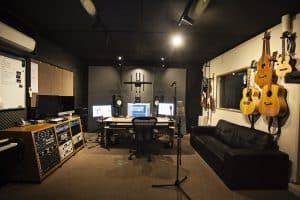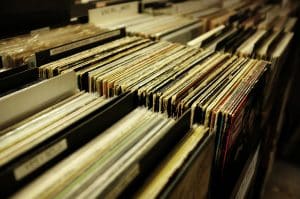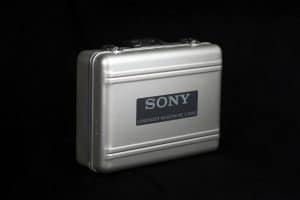Green Screen and Recording Studios
In the modern digital age of Smart Phones and YouTube, a lot of our clients are reaching their clients through video. Whether it is corporate videos or musicians who need a presence on YouTube, the worlds of Video and Audio have become increasingly reliant on each other to break through the noise. The Green Screen has become a critical tool in the creation of video content and we use it all the time in our studio.
How We Use the Green Screen
The Green Screen allows us to insert a unique backdrop behind the performer or speaker. The subject. For example, we can film a musician performing in front of our Green Screen, and then place a busy bar as the backdrop behind them playing. What’s the benefit of doing this? Well, this means that we can capture the high quality sound of the recording studio, and then make it seem as though that sound was recorded live. In a live setting, it would be very difficult to get such a controlled and high quality sound. The use of the green screen allows us to achieve these high-quality results for our clients. It is one of our most powerful tools we employ in our studio.
Alternatively, We use the Green Screen to film “talking-head” videos. These are similar looking videos to what you’d see when you watch the news on television. The news reporter is talking directly to the camera whilst the backdrop of a city is placed behind them.
So, how does the Green Screen actually work?
How Green Screen Footage is Manipulated
Well, basically, our programs look at the footage that has been shot with the Green Screen and will select a colour that it wishes to extract from the footage. In most cases it is Green in colour. We then set about “keying” out all the green that is sitting behind the subject. Once all the green has been taken out of the footage we can then insert the background. This will either be a moving background or a still background. Moving backgrounds is footage that has been shot previously and will sit behind the subject. A still picture is just a photo or image that is not moving.
Once the background has been inserted we then need to go about matching the colours of the background and of the subject. This is, the subject and the background don’t look like they are completely separate images and shot at different times. The goal is that we want the viewer of the video to truly believe that the person, or subject, was filmed with the background behind them, simultaneously. So, if we insert mountains behind our subject, then we really want viewers to believe that they were standing on an epic mountain ridge whilst they were being filmed. If it doesn’t look like this then we have failed and the video will look cheesy and cheap. This is not our goal.
The Green Screen saves our client the money by not having to drag thousands of dollars of expensive equipment to exotic locations or inner city bars. It can all be done in our controlled space. Our studio.
Limitations of Green Screen Production
It goes without saying that Green Screen work does have its limitations. For example, the camera usually needs to be fixed. This wouldn’t be the case if you were actually filming in a location with the real backdrop. The lighting needs to be fixed during green screen work. If the lighting changes during the process of filming to a green screen then it makes it impossible to key out the green from the footage. Also, the subject (actor or performer) cannot wear green, and there can be no green objects in the footage. The reason for this is that the program will “key” out the green from their clothing, also. This will make the subject look see-through and will ultimately be unconvincing to the viewer. This is an immediate giveaway that the video was made with a green screen. It is not what we aim to achieve.
Here at Crash Symphony Productions we choose to work with the Adobe suite and Final Cut Pro X. Both these programs are designed to handle Green Screen footage very well. These programs have helped us create some great videos for our clients. Some are viewable in our portfolio.
The Teleprompter and Green Screen
Often we are asked about creating videos where there is a lot of content that needs to be read by the actor. For this purpose we have a studio teleprompter. This device works very well with our Green Screen projects. Our camera will shoot through this teleprompter. On the other side of the teleprompter glass there is the text content that is projected on to the reflective surface. This is then reflected in the direction of the actor who can read it. This means that actor can be reading the content whilst looking straight down the barrel of the camera, and the green screen will be behind them. It will not appear that the actor is reading content whilst they are being filmed. Often the giveaway to “content” reading is the actor looking elsewhere rather than directly at the camera whilst speaking. This device is critical for making good talking head videos in conjunction with our Green Screen.
Green Screen Equipment
Having a good Green Screen and teleprompter isn’t quite enough. We also have the latest high-tech DSLR video cameras onsite, too. These cameras record extremely high-resolution video footage that makes the videos look extremely impressive to the viewers. These cameras work well with our lighting rig, which is specifically designed for green screen work.
One set of high-powered lights is used to illuminate the green screen with the aim of creating a homogeneously lit backdrop. The other set of lights is used to light the subject. There will need to be enough distance between the performer and the Green Screen so that they don’t intrude (at all) on each other’s lighting. That means, no shadows on the green screen, and ideally, no glow of green on the performer. Separation is critical in attaining usable footage. The final light that is used is called the “key-light”. This has the sole purpose of lighting the subject and creating a sense of lighting direction. For example, if we are going to place a backdrop behind our subject, where it appears that he sun is shining from the east, then we need to create that lighting direction with the key-light. Being aware of the lighting directionality is another pivotal component to achieving believable content behind the performer. All these aspects need to be considered during the filming process.
Our History with the Green Screen
Whilst Crash Symphony Productions is primarily a Recording Studio, the overwhelming demand for video content from our clients has drawn us into this arena. The audio and video world have become so closely infused since the birth of the internet, and the advances in technology, that it has meant that studios have become increasingly multi-skilled. Our unique point of difference is that Crash Symphony Productions was a recording studio first. Often, filmmakers can be very aware of visual content and equipment, but let the audio fall to the wayside. We are strong in both these areas.
How you benefit from the Green Screen
Almost all of our clientele are turning to well-captured video to sell their product. In most cases, these video clients will require us to take them through the process of story-boarding their video, to recording and filming it, editing the video and audio, composing music for the video, and finally providing them with a quality master.
Please contact us regarding all your questions and enquiries for Green Screen and video projects.




